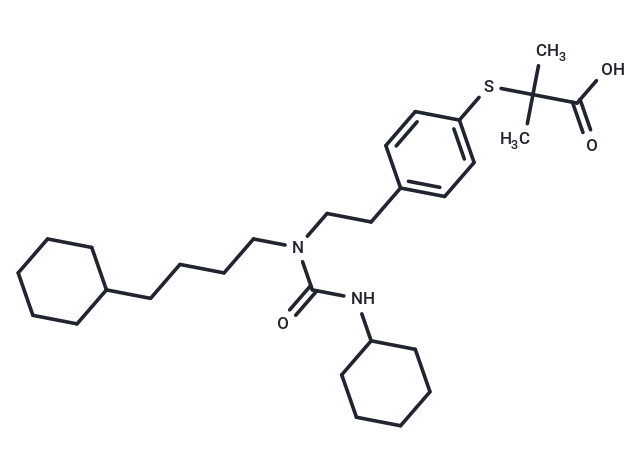Shopping Cart
- Remove All
 Your shopping cart is currently empty
Your shopping cart is currently empty

GW 7647 is an effective and highly selective PPARα agonist, the EC 50 values of human PPARα, PPARγ and PPARδ receptors are 6,1100 and 6200 nM, respectively. GW 7647 can reduce the production of nitric oxide in macrophages and has lipid-lowering and anti-inflammatory properties in the body.

| Pack Size | Price | Availability | Quantity |
|---|---|---|---|
| 1 mg | $45 | In Stock | |
| 5 mg | $98 | In Stock | |
| 10 mg | $150 | In Stock | |
| 25 mg | $256 | In Stock | |
| 50 mg | $441 | In Stock | |
| 100 mg | $636 | In Stock |
| Description | GW 7647 is an effective and highly selective PPARα agonist, the EC 50 values of human PPARα, PPARγ and PPARδ receptors are 6,1100 and 6200 nM, respectively. GW 7647 can reduce the production of nitric oxide in macrophages and has lipid-lowering and anti-inflammatory properties in the body. |
| Targets&IC50 | PPARγ:1.1 μM (EC50)( Human PPARγ), PPARα:6 nM (EC50)( Human PPARα), PPARδ:6.2 μM (EC50)( Human PPARδ) |
| In vitro | GW7647 at a concentration of 50 nM, promotes PI3K and Akt (Ser473) phosphorylation, leading to an increase in NOS1 phosphorylation and subsequently elevating NO levels in stripped antral mucosa. Additionally, at the same concentration, it boosts the initial phase of Ca2+-mediated exocytotic events triggered by ACh in antral mucous cells, without independently inducing any exocytotic events. At a higher concentration of 1 μM, GW7647 substantially elevates PDZK1 protein levels to 129.7 ± 6.5% compared to controls in Caco2BBE cells, irrespective of IL-1β presence, and mitigates the IL-1β-induced reduction in PDZK1 expression. When combined with ACh, GW7647 augments the impact of wortmannin (50 nM) and AKT-inh (100 nM) on exocytotic activity in these cells. At 100 nM, GW7647 significantly decreases AQP9 protein levels by 43% in WIF-B9 hepatocytes and by 24% in HepG2 cells, though it shows no notable effects at 10 and 1,000 nM in WIF-B9 hepatocytes, nor does it significantly affect L-FABP protein levels in HepG2 hepatocytes. |
| In vivo | GW7647 (3 mg/kg per day) does not prevent cardiac hypertrophy but preserves left ventricular ejection fraction in vivo [4]. |
| Molecular Weight | 502.75 |
| Formula | C29H46N2O3S |
| Cas No. | 265129-71-3 |
| Smiles | CC(C)(Sc1ccc(CCN(CCCCC2CCCCC2)C(=O)NC2CCCCC2)cc1)C(O)=O |
| Relative Density. | 1.12 g/cm3 |
| Storage | Powder: -20°C for 3 years | In solvent: -80°C for 1 year | Shipping with blue ice. | |||||||||||||||||||||||||||||||||||
| Solubility Information | DMSO: 60 mg/mL (119.34 mM), Sonication is recommended. | |||||||||||||||||||||||||||||||||||
Solution Preparation Table | ||||||||||||||||||||||||||||||||||||
DMSO
| ||||||||||||||||||||||||||||||||||||

Copyright © 2015-2025 TargetMol Chemicals Inc. All Rights Reserved.